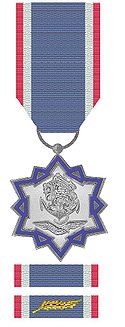- Decoration of Merit
-
Decoration of Merit 
The silver Decoration of Merit with ribbon barsAwarded by  Netherlands Ministry of Defence
Netherlands Ministry of DefenceType Military decoration,
with degrees gold and silverAwarded for See text Status Currently awarded Statistics Established 16 April 1987 Precedence Next (higher) Medal of Recognition Next (lower) Cross for Important War Actions The Decoration of Merit is an important military decoration for bravery in the Netherlands The medal was established by the Dutch minister of defence Wim van Eekelen on 16 April 1987. The award was created by ministerial decree and is therefore a medal of the Netherlands Ministry of Defence and not a royal decoration.
Defence ministries in Germany and the Czech Republic award similar decorations. This way chivalric orders keep their exclusivity.
The ministerial decree requires four criteria for granting:
- exceptional merits towards the armed forces which are incidentally of nature,
- individual courage in life-threatening situations,
- brave action in conflict situations in peace time, and
- particular merits of Dutch and foreign civil and military authorities.
In 2002, minister Benk Korthals added a fifth criteria for granting the medal:
- exceptional activities for the Netherlands Armed forces.
The award is granted in silver or gold.
The medal is the sixth highest military decoration, after the Medal of Recognition, still being awarded for bravery.
Design
The medal has the shape of an old Dutch fortresses in the style that was introduced in the late 17th century by the Dutch fortress builder Menno van Coehoorn. The moat of the hexagonal fortresses has been reflected in blue emaille. In the middle of the depicted fortresses the symbols of three of the four branches of the Netherlands armed forces are displayed. These are the "climbing lion with sword and arrows" of the Royal Netherlands Army, the "anchor" of the Royal Netherlands Navy, and the "flying eagle" of the Royal Netherlands Air Force. The "burning grenade", the symbol of the fourth branch, the Royal Marechaussee, is lacking. On the reverse side, the words "KONINKRIJK DER NEDERLANDEN" (English: Kingdom of the Netherlands) and "MINISTER VAN DEFENSIE" (English: Minister of Defence) are engraved in a circle.
The medal is worn with a Nassau blue ribbon that has narrow red and white borders. Recipients may wear a ribbon bar at their uniform with the same composition (although on the ribbon bar of the golden medal a golden palm branch is added).
American sergeant posthumously awarded
On 12 September 2007 American sergeant Alexander van Aalten, (a descendant of Dutch ancestors) posthumously received the Decoration of Merit in gold. In April 2007 Van Aalten, while in Afghanistan, volunteered to assist with the salvage of a fallen Dutch Corporal Strikl who had been killed by an improvised explosive device. Van Aalten was however killed himself by a land mine while attempting to retrieve the body of Strikl. The golden Decoration of Merit was presented by Netherlands minister of defence Eimert van Middelkoop to the widow Shana van Aalten. As result of this high Dutch honour the body of sergeant Van Aalten was re-buried at Arlington National Cemetery.
Van Aalten was linked to the 82nd Airborne 1-508 PIR, a so-called airborne infantry division. The 82nd Airborne played a large role in the liberation of the Netherlands during the second world war. In the Battle of Arnhem this division suffered heavy losses. Queen Wilhelmina of the Netherlands let attach the cross of Military William Order to the standard of the regiment for the liberation of Nijmegen.
Categories:- Orders, decorations, and medals of the Netherlands
- Awards established in 1987
- Order, decoration, and medal stubs
- Netherlands stubs
Wikimedia Foundation. 2010.
